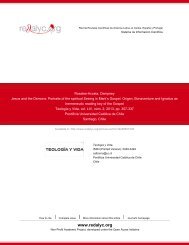A Key Concept in Modern Translation Theory - Redalyc
A Key Concept in Modern Translation Theory - Redalyc
A Key Concept in Modern Translation Theory - Redalyc
You also want an ePaper? Increase the reach of your titles
YUMPU automatically turns print PDFs into web optimized ePapers that Google loves.
SERGIO BOLAÑOS CUELLAR<br />
65<br />
Non-L<strong>in</strong>guistics/Context-oriented theories strive to understand translation<br />
as a culture-bound phenomenon, where the most important aspect is the<br />
translator’s role and the effect the Source Language Text (SLT) will have on the<br />
Target Language audience (readers) (cf. <strong>in</strong>fra). With<strong>in</strong> this approach the role<br />
played by ST <strong>in</strong> the translation process is rather ancillary, i.e. it is the po<strong>in</strong>t of<br />
departure for the translation process but once the process has begun there exists<br />
no compell<strong>in</strong>g reason whatsoever to come back to it. One may say that it has<br />
already served its purpose. What actually matters <strong>in</strong> this contextual approach is<br />
how translation can be accounted for by the cultural and historical factors<br />
surround<strong>in</strong>g it.<br />
We can briefly describe some of the most important COT by us<strong>in</strong>g J. House’s<br />
(1997) characterization 4 .<br />
Anecdotal, Biographical and Neo-hermeneutic Approaches. They<br />
correspond to the typical anecdotal (=subjective) reflections made by generations<br />
of professional translators, poets, writers, philologists and philosophers (ibid p.2).<br />
In this approach the understand<strong>in</strong>g and <strong>in</strong>terpretation of the orig<strong>in</strong>al and the<br />
translation are <strong>in</strong>dividual, creative acts that cannot be generalized or systematized<br />
(ibid). The translator’s subjective <strong>in</strong>terpretation and transfer decisions are based<br />
on his l<strong>in</strong>guistic and cultural <strong>in</strong>tuitive knowledge and experience. The relation<br />
between orig<strong>in</strong>al and translation and the expectations of the target text readers<br />
are not given the attention they deserve, and the problem of dist<strong>in</strong>guish<strong>in</strong>g between<br />
a translation and various types of versions and adaptations is not even recognized<br />
(ibid). Some authors with<strong>in</strong> this approach are: Paepcke 1986; Stolze 1992;<br />
Kupsch-Losereit 1994.<br />
Response-oriented, Behavioral Approaches. For House “assum<strong>in</strong>g that it is<br />
true that a translation should produce equivalent responses, the question rema<strong>in</strong>s,<br />
however, whether the degree to which this requirement is met, can be empirically<br />
tested. If it cannot be tested, it seems fruitless to postulate the requirement, and<br />
the appeal to ‘equivalence of response’ is really of no more value than the<br />
philologists’ and hermeneuticists’ criterion of ‘captur<strong>in</strong>g the spirit of the orig<strong>in</strong>al’”.<br />
This approach “all but ignores the raison d’être of any translation which<br />
4<br />
In House’s proposal Literature Oriented Approaches, Post-<strong>Modern</strong>ist Deconstructionist<br />
Approaches, and Functionalistic and Action and Reception- <strong>Theory</strong> Related Approaches are<br />
classified as Text-based Approaches. On the contrary, <strong>in</strong> our proposal we consider them to be<br />
Context-oriented theories (COT) because they are not based on the assumption that <strong>in</strong> translation<br />
a relation of equivalence between ST and TT necessarily holds, and the l<strong>in</strong>guistic nature of the<br />
text is not essential <strong>in</strong> their understand<strong>in</strong>g of translation.
















